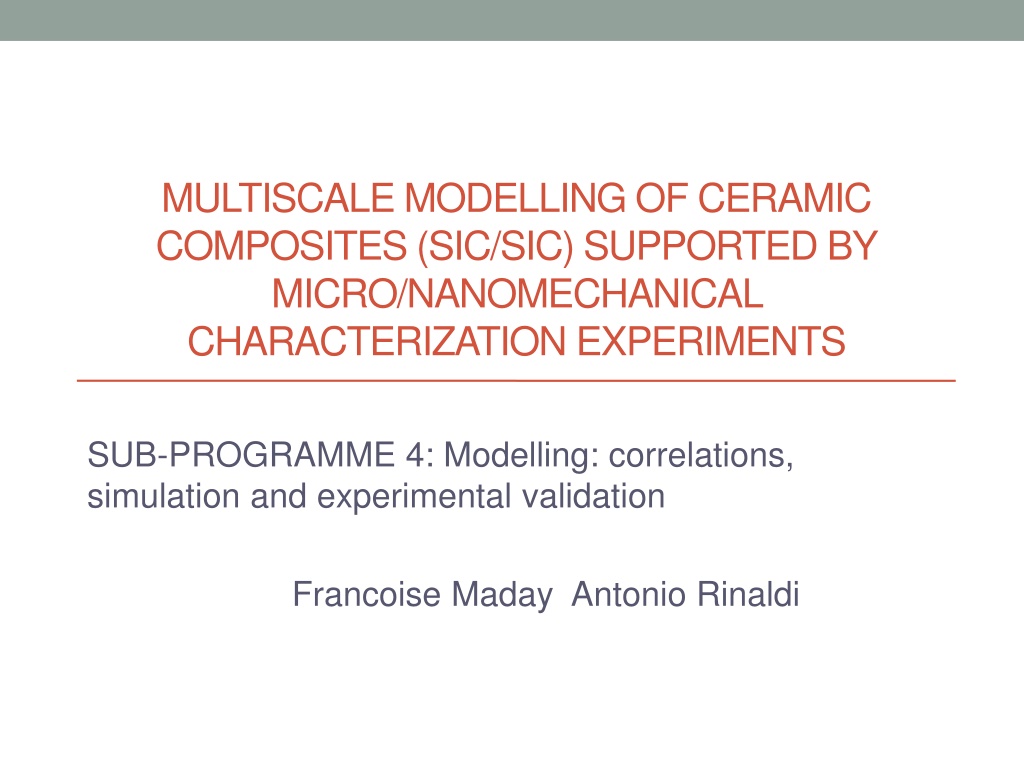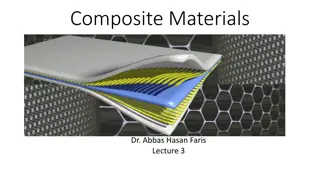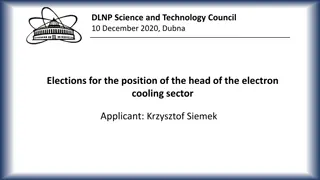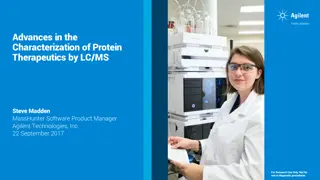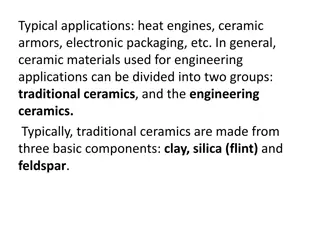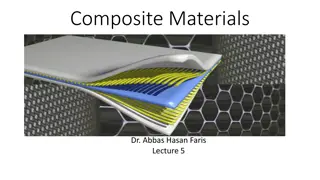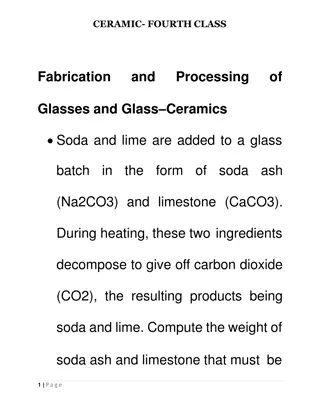Advances in Ceramic Composite Property Modeling and Experimental Characterization
European research focuses on advanced modeling of C/C, C/SiC, and SiC/SiC composites for aerospace and nuclear applications, with an emphasis on correlating simulations with experimental validation. Laboratories are progressing towards a multiscale approach, integrating micro/nanomechanical characterization techniques to analyze mechanical behavior and damage properties of ceramic composites. Experimental testing platforms at ENEA offer capabilities for macro, micro, and nanoscale testing to support the development and validation of composite models.
Download Presentation

Please find below an Image/Link to download the presentation.
The content on the website is provided AS IS for your information and personal use only. It may not be sold, licensed, or shared on other websites without obtaining consent from the author. Download presentation by click this link. If you encounter any issues during the download, it is possible that the publisher has removed the file from their server.
E N D
Presentation Transcript
MULTISCALE MODELLING OF CERAMIC COMPOSITES (SIC/SIC) SUPPORTED BY MICRO/NANOMECHANICAL CHARACTERIZATION EXPERIMENTS SUB-PROGRAMME 4: Modelling: correlations, simulation and experimental validation Francoise Maday Antonio Rinaldi
STATUS ABOUT CERAMIC COMPOSITE PROPERTY MODELING IN THE EU Advanced models for C-or SiC-based composite properties are mainly developed at a European level by French laboratories: C/C and C/SiC for aerospace applications: Unit Mixte-Laboratoire des Composites Thermo-Stucturaux de Pessac (LCTS) Office National de Recherche et d tudes Aerospatiales - ONERA Ecole Normale Sup rieure de Cachan (ENS) SiC/SiC for nuclear applications (i.e.fuel cladding) CEA Multiscale approach based on microstructures more and more representative of the real ones (at each length scale) and using numerical resolution tools have significantly progressed. Studies include modelling of: Linear elastic behaviour Non linear behaviour due to damage Thermal properties Oxidation Complementary experimental data might be needed in order to validate these models
TESTING PLATFORMS AVAILABLE AT ENEA 1. SET OF MACRO TENSILE AND CREEP STATIONS FOR MACRO TESTING (Differential Interference Contrast used to capture microfields during testing) 2. MICROTESTING SYSTEM WITH LOAD CELLS OF 2N and 200 N TO BE OPERATED UNDER AN OPTICAL MICROSCOPE OR IN SEM + VIDEO MONITORING CAPABILITY To pull on microcomposite , single yarns, and single fibers 3. AFM WITH NANOMECHANICAL MODEL TO DO ELASTIC MAPPING OF MATRICES UP TO 64x64 OVER 100x100 um2(SUPPORTING SPECIAL SAPPHIRE CANTILEVER FOR CERAMICS) In-situ push-in on fibers or map strain field with nanometer resolution during an external test (if coupled with the microtensile stage)
TESTING PLATFORMS AVAILABLE AT ENEA 4. NANOINDENTER FOR QUANTITATIVE MEASUREMENT OF MECHANICAL PROPERTIES (RESIDUAL STRESS) AT THE NANOSCALE (THIS WILL BECOME AVAILABLE OVER SUMMER) Ultra precise positioning and high stiffeness testing on fibers and nanophases by a diamond tip 5. FULL ACCESS TO A FOCUSED ION BEAM (FIB) TO SUPPORT NEEDS FOR SECTIONING SiC/SiC and DIAMOND TIPS AS NEEDED , AS WELL AS TO PREPARE MICROMETER SCALE NOTCHED SAMPLED FOR FRACTURE TESTING
POTENTIAL CONTRIBUTION FROM ENEA PROVIDING EXPERIMENTAL DATA IN SUPPORT TO THE MULTI- SCALE APPROACH OF THE MECHANICAL BEHAVIOUR OF SIC/SIC COMPOSITES AT THE SCALE OF THE TOW: NANOINDENTATION TESTS TO EVALUATE THE INTERFACE PROPERTIES (SHEAR STRESS, DEBOND ENERGY AND RESIDUAL STRESSES ) FROM THE NANOSCALE OF SIC/SIC IN-SITU MICROSCOPIC OBSERVATIONS (OPTICAL, SEM) DURING TENSILE TESTS TO CHARACTERIZE THE ELASTIC AND DAMAGE BEHAVIOUR OF SIC/SIC MINICOMPOSITES
